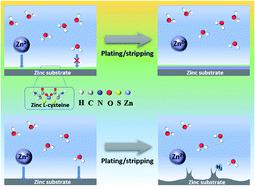当前位置:
X-MOL 学术
›
J. Mater. Chem. A
›
论文详情
Our official English website, www.x-mol.net, welcomes your feedback! (Note: you will need to create a separate account there.)
A hydrophobic layer of amino acid enabling dendrite-free Zn anodes for aqueous zinc-ion batteries
Journal of Materials Chemistry A ( IF 11.9 ) Pub Date : 2022-07-29 , DOI: 10.1039/d2ta04015h Qing Wen 1, 2 , Hao Fu 1, 2 , Zhen-yu Wang 1, 2 , Ying-de Huang 1, 2 , Zhen-jiang He 1, 2 , Cheng Yan 3 , Jing Mao 4 , Kehua Dai 5 , Xia-hui Zhang 6 , Jun-chao Zheng 1, 2
Journal of Materials Chemistry A ( IF 11.9 ) Pub Date : 2022-07-29 , DOI: 10.1039/d2ta04015h Qing Wen 1, 2 , Hao Fu 1, 2 , Zhen-yu Wang 1, 2 , Ying-de Huang 1, 2 , Zhen-jiang He 1, 2 , Cheng Yan 3 , Jing Mao 4 , Kehua Dai 5 , Xia-hui Zhang 6 , Jun-chao Zheng 1, 2
Affiliation

|
Aqueous rechargeable zinc ion batteries have attracted increased attention for large-scale energy storage owing to their cost-effectiveness, safety and high volumetric energy density. However, aqueous rechargeable zinc ion batteries still face several challenges such as uncontrolled growth of zinc dendrites and side reactions, which seriously hinder their practical applications. Herein, we propose a strategy of interfacial engineering to kill two birds with one stone by introducing a zinc L-cysteine functional layer (Cys–Zn) with a unique sulfhydryl group on the surface of the Zn anode. This Cys–Zn layer not only improves the hydrophobicity of the zinc anode at the solid–liquid interface and thus mitigates the corrosion of the zinc anode, but also guides uniform zinc deposition. Besides, the in situ etching of Zn foil using L-cysteine not only leads to preferential exposure of the (002)Zn plane that further helps guide uniform deposition of zinc, but also removes the native oxide layer on Zn foil, leading to increased electrochemical surface area and reduced interfacial resistance. The computational results indicate that the Cys–Zn layer is strongly adsorbed on Zn foil to mitigate the penetration of zinc dendrites, while having great corrosion resistance against aqueous electrolytes. As such, the Cys–Zn-coated zinc anode achieved a stable long-term cycling performance over 2000 h for 2 mA h cm−2 at 2 mA cm−2 in Zn symmetrical cells. Besides, the Cys–Zn-coated zinc anode showed enhanced rate and cycling performance in Zn||MnO2 full cells and Zn||Cu half-cells, when compared with the bare Zn anode. We anticipate that this study provides a new interface modification layer on the inhibition of zinc dendrites and side reactions.
中文翻译:

氨基酸疏水层使水性锌离子电池的无枝晶锌阳极成为可能
水系可充电锌离子电池由于其成本效益、安全性和高体积能量密度而在大规模储能方面引起了越来越多的关注。然而,水系可充电锌离子电池仍面临锌枝晶生长失控和副反应等诸多挑战,严重阻碍了其实际应用。在此,我们提出了一种界面工程策略,通过在锌负极表面引入具有独特巯基的锌L-半胱氨酸功能层 (Cys-Zn),用一块石头杀死两只鸟。这种 Cys-Zn 层不仅提高了锌负极在固液界面的疏水性,从而减轻了锌负极的腐蚀,还引导了锌的均匀沉积。此外,使用L-半胱氨酸原位蚀刻 Zn 箔不仅导致 (002) Zn平面的优先暴露,这进一步有助于引导锌的均匀沉积,而且还去除了 Zn 箔上的天然氧化物层,从而增加了电化学表面积和降低界面阻力。计算结果表明,Cys-Zn 层强烈吸附在锌箔上,以减轻锌枝晶的渗透,同时对水性电解质具有良好的耐腐蚀性。因此,Cys-Zn 涂层锌阳极在 2 mA cm -2和 2 mA cm -2下实现了超过 2000 小时的稳定长期循环性能在锌对称细胞中。此外,与裸锌负极相比,Cys-Zn 包覆的锌负极在 Zn||MnO 2全电池和 Zn||Cu 半电池中表现出更高的倍率和循环性能。我们预计这项研究为抑制锌枝晶和副反应提供了一个新的界面改性层。
更新日期:2022-07-29
中文翻译:

氨基酸疏水层使水性锌离子电池的无枝晶锌阳极成为可能
水系可充电锌离子电池由于其成本效益、安全性和高体积能量密度而在大规模储能方面引起了越来越多的关注。然而,水系可充电锌离子电池仍面临锌枝晶生长失控和副反应等诸多挑战,严重阻碍了其实际应用。在此,我们提出了一种界面工程策略,通过在锌负极表面引入具有独特巯基的锌L-半胱氨酸功能层 (Cys-Zn),用一块石头杀死两只鸟。这种 Cys-Zn 层不仅提高了锌负极在固液界面的疏水性,从而减轻了锌负极的腐蚀,还引导了锌的均匀沉积。此外,使用L-半胱氨酸原位蚀刻 Zn 箔不仅导致 (002) Zn平面的优先暴露,这进一步有助于引导锌的均匀沉积,而且还去除了 Zn 箔上的天然氧化物层,从而增加了电化学表面积和降低界面阻力。计算结果表明,Cys-Zn 层强烈吸附在锌箔上,以减轻锌枝晶的渗透,同时对水性电解质具有良好的耐腐蚀性。因此,Cys-Zn 涂层锌阳极在 2 mA cm -2和 2 mA cm -2下实现了超过 2000 小时的稳定长期循环性能在锌对称细胞中。此外,与裸锌负极相比,Cys-Zn 包覆的锌负极在 Zn||MnO 2全电池和 Zn||Cu 半电池中表现出更高的倍率和循环性能。我们预计这项研究为抑制锌枝晶和副反应提供了一个新的界面改性层。



























 京公网安备 11010802027423号
京公网安备 11010802027423号